Merry Cemetery: A Different Way to Look at Death
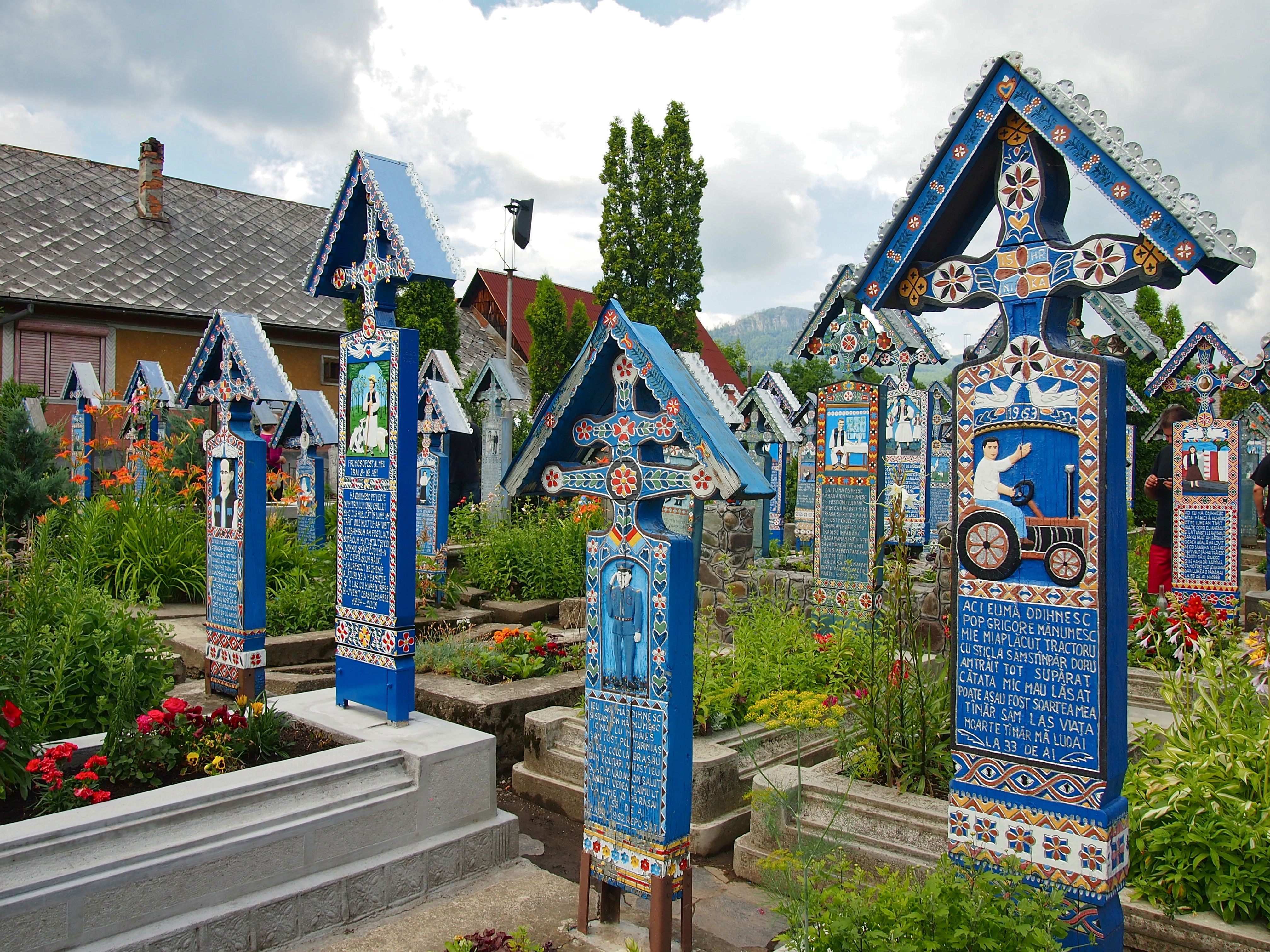
When I say “old cemetery,” what do you picture?
Crumbling tombstones? Grand old mausoleums? Overgrown shrubbery?
Chances are, whatever you picture is fairly dark; morose; depressing. Because, in Western culture especially, Death is usually a dark, morose, and depressing subject. Even though old cemeteries may be grand and people may visit them (yes, cemetery tourism is a thing), they nearly all project a feeling of sadness to some degree, no matter where in the world they are located.
But not Merry Cemetery.
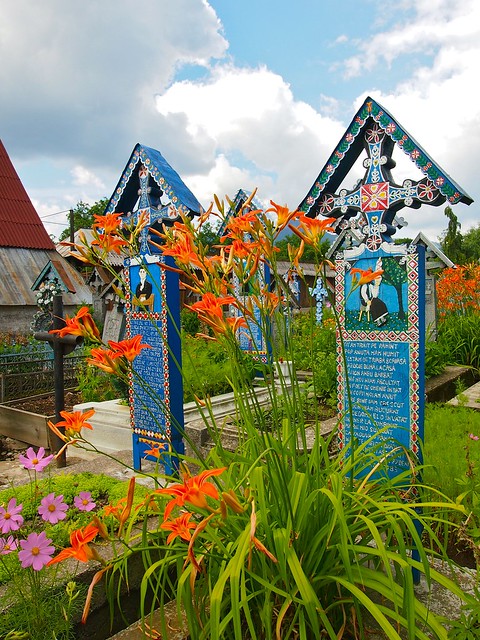
Not far from the small town of Sighetu Marmaţiei in the Maramures region of Romania lies Săpânţa, an unassuming little village where it seems like nothing has changed for the past 100 years. Farmers still go about their work in horse-drawn carts, and old women still wear patterned scarves on their heads.
But Săpânţa has a very unique claim to fame — it is home to Cimitirul Vesel, or “Merry Cemetery.”
This cemetery is unlike any I have ever seen; in fact, it's unlike any other cemetery in the world.
Here, instead of the usual boring stone grave markers and marble mausoleums that populate just about every other graveyard in the world, each plot is adorned with a colorfully-painted wooden cross, with a poem for a epitaph.
The crosses — mostly blue with other bright highlights — show a photo of the deceased (pictured either at the moment of death, or doing his/her favorite thing in life) and offer up a glimpse into the lives of the dead through fun — and sometimes funny — poems.
This cemetery is far from being a place for solemn reflection.
In fact, you could say it's downright light-hearted!
A man by the name of Stan Ioan Pătraş began the tradition of these crosses back in 1935, and his work was carried on by one of his apprentices, Dumitru Pop (AKA Tincu). The crosses were Pătraş' unique way of immortalizing his community in a way that celebrated life instead of mourning death.
Each poem/epitaph is written in the first person (in Romanian), and Pătraş would usually write these little anecdotes himself after getting to know the deceased through his/her family. Families could also write their own poems, however, and it's often these ones that are the most humorous.
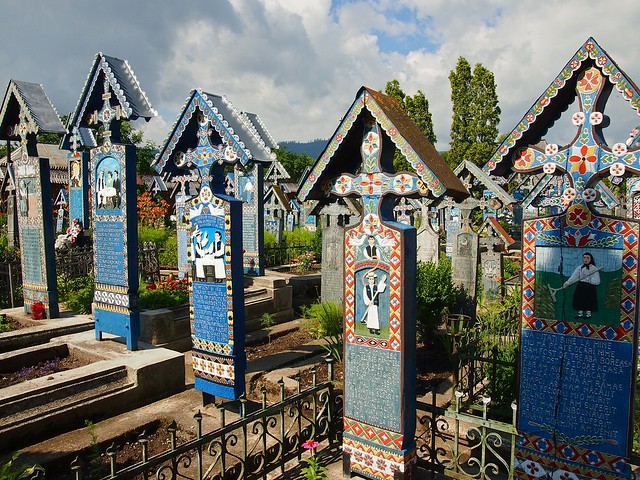
Many crosses depict a cause of death (a common one being car/truck accidents), but others focus on hobbies and occupations — things that made these people happy.
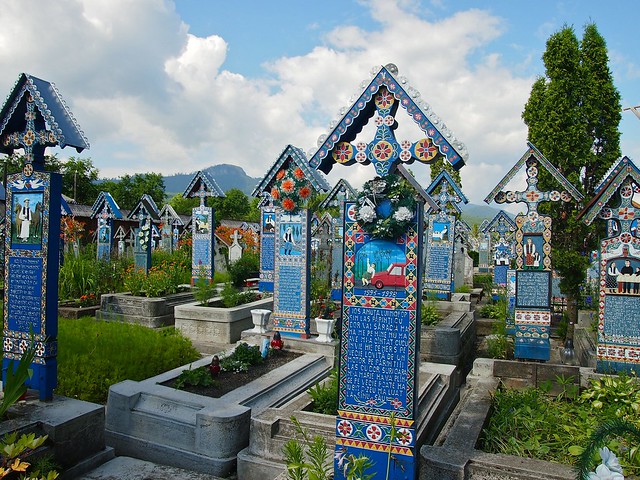
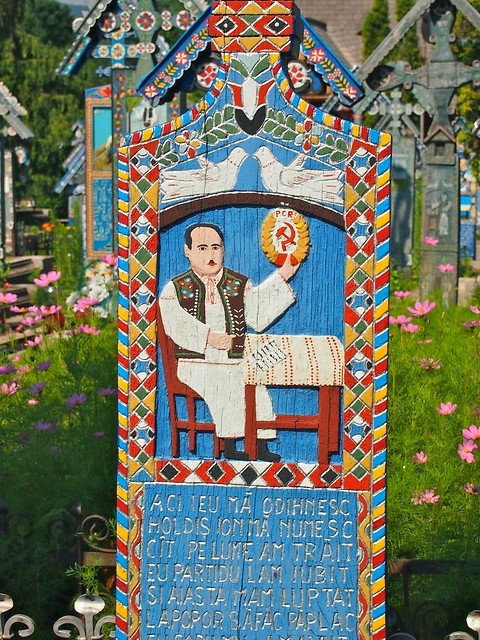
There are, of course, bizarre and amusing crosses, too. (And lucky we had a Romanian guide with us who could tell us some of the best stories.)
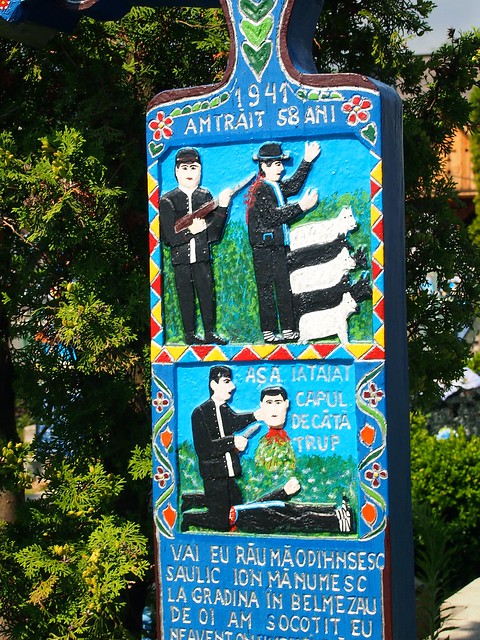
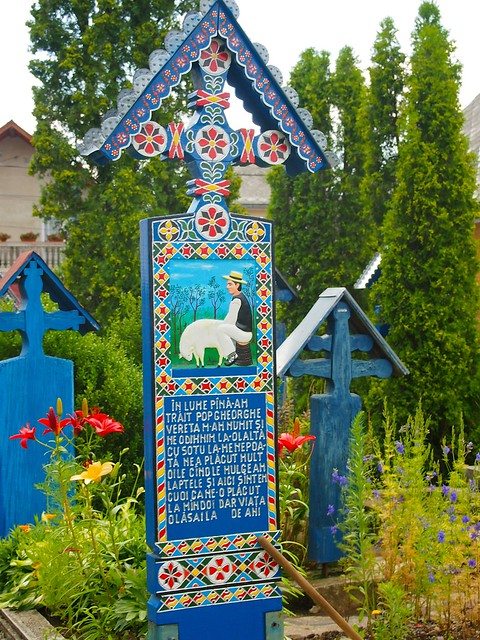
And, while most epitaphs simply explain a bit about each person's life, others act as warnings to those who might read them.

Today, Merry Cemetery is a national historic site that sees a trickle of visitors each day (though it's also still a functioning cemetery and locals can be buried here if they wish). It makes a fun afternoon stop if you're in the Maramures region to check out some of Romania's UNESCO-recognized painted churches, and is well worth a detour.
In the end, this quote from the cemetery says it all:
The Merry Cemetery is a unique place of pilgrimage. It is a place where people come to mourn their dead, but, above all, it is a place expressing in a very deep and optimistic manner the true meanings and beauties of life.
I think the world needs more Merry Cemeteries.
How about you?
READ NEXT: Cemeteries Around the World
*Note: I am on a complimentary “Explore Eastern Europe” tour with Intrepid Travel, but all opinions are completely my own.
If you're interested in doing the same tour I did, you can check it out here.

Amanda Williams is the award-winning blogger behind A Dangerous Business Travel Blog. She has traveled to more than 60 countries on 6 continents from her home base in Ohio, specializing in experiential and thoughtful travel through the US, Europe, and rest of the world. Amanda only shares tips based on her personal experiences and places she's actually traveled!

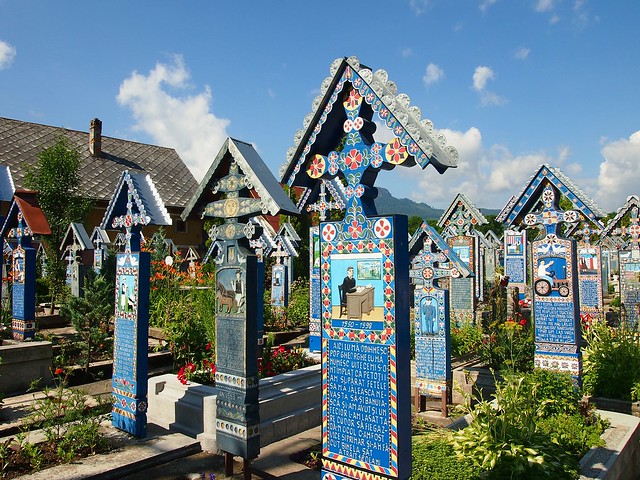
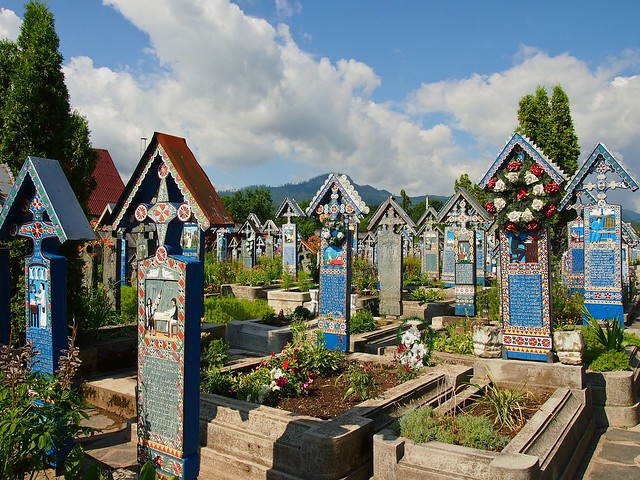

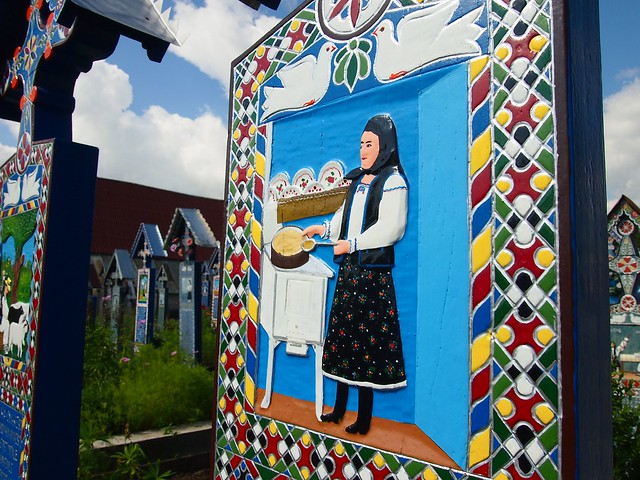
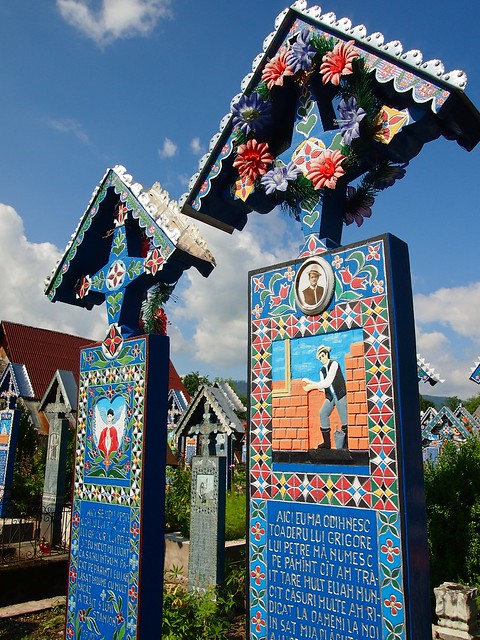


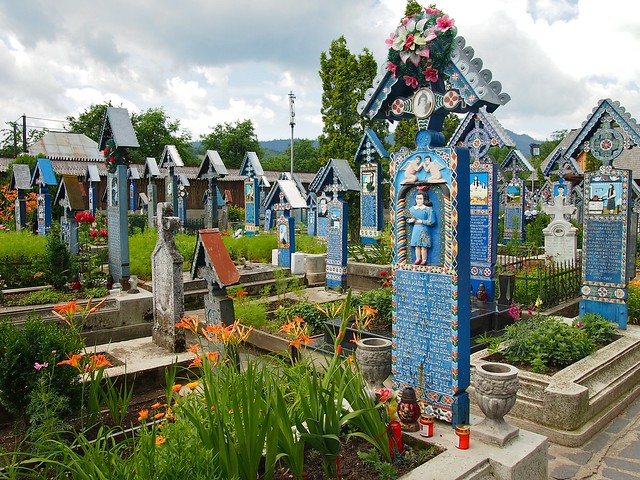
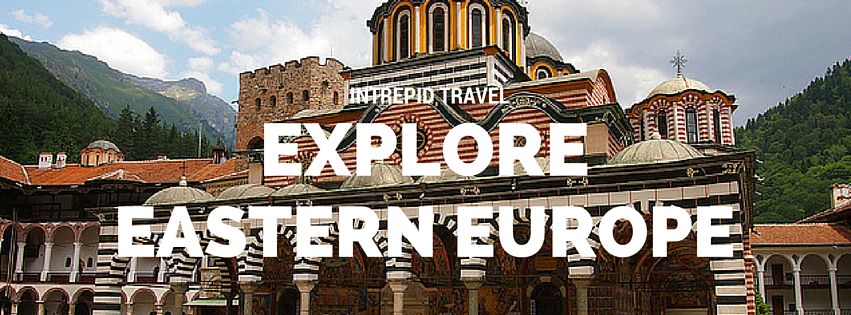









Even though I’m Romanian, it was not until last year that I visited this place. To be honest, it was not how I expected, I guess the word merry (ro: vesel) gave me different expectations. What I actually found was an emotional place, that provided a glimpse into the lives of the people buried there: their accomplishments, family, happy times and tragedies. It helps to know the language as you can better understand their stories, but i think you can be touched even if you don’t know Romanian.
It’s such a fascinating place; I’m glad you were able to visit!
Hi Amanda
Great post to help me plan a trip to Romania next spring.
A question – did you visit the Painted monasteries and the Wooden churches in the Maramures region? Did you stay at Cluj-Napoca? If so any recommendations for hotels there?
Thank you,
Vinodh
I did spend some time in the Maramures region, and we visited one or two churches as part of a larger tour of the area. I stayed in a village called Vadu Izei at a place called Pensiunea Ardelean, which was lovely!
Thank you.
I’m looking for a person who has attended a funeral at the Merry Cemetery who is interested in sharing his or her story for a research project. If anyone who reads this is interested, please reply! Thanks!
I am actually from Romania and I have been 3 times to “Cimitirul Vesel” , how it’s pronounced in romanian and it’s a really lovely place to visit. It’s something about it that makes you happy, although it is commonly a place of sadness.
I’m from Romania , i read this article and yes it’s very funny in this graveyard. Try the traditional food when you visit Romania.
I enjoyed this cemetery a lot! (Which I know is kind of weird, but it’s an interesting place!)
What a beautiful place. Cemeteries are among my favored photographic subjects. You’ve captured this so well! Thank you!
I really like visiting cemeteries, too – especially ones as unique as this!
I love this! I love the beautiful decorations on all the grave markers and how much personality they contain. I wish that more graveyards would have monuments like these, even if some of them can get a bit out of the ordinary. Could you imagine paying respects to an ancestor whose decapitation was displayed on the grave marker? Anyway, thanks for sharing.
It’s a fascinating place!!
[…] There were gigantic and heavily decorated poles stuck in the earth. I was honestly surprised. Did they really had something to do with all that vampire nonsense? And…of course not! Funerary poles keep alive the long and honourary Romanian woodcarving tradition. The North of Transylvania is famous for exquisite woodcarvings and beautiful cemeteries. Have you ever heard of the Merry Cemetery? […]
Beautiful article! I enjoyed reading it. The Merry Cemetery from Sapanta has become truly famous worldwide due to the ways in which the locals chose to laugh at Death.
Did you know that the first tombs were adorned at the initiative of the folk craftsman Stan Ioan Patras, who wanted to add a humorous note to these inherently sad goodbyes? Today, the tradition is carried on by his apprentice, Dumitru Pop Tincu, and the Merry Cemetery now counts over 800 bright-coloured crosses.
Yes, it’s such an interesting place! I’m so glad I got to visit.
What an unusual cemetery. When I travelled to Northern Argentina (near Bolivia) I was surprised by the colourful Indian cemeteries. Quite as colourful like the one you pictured in your post. It had a nice feel to it, as if it was a place to celebrate more than to weep.
You can find colorful cemeteries in Central America, as well as in Asia, too (I saw a very colorful one in Vietnam, for example). This one definitely celebrates life, though! The little stories on each grave marker make it so unique.
This is fantastic! I love cemeteries and tombs; this is amazing. I love the pictures and stories; so colourful.
Thanks, Marsha! It was such a cool place to visit!
[…] >> Read about Merry Cemetery here. […]
I just visited this cemetery and I really liked it. It was a pity I didn’t have so much time available to read all the stories. For me, the funniest I found was the one related to the mother-in-law written by the son-in-law: “here rests my mother-in-law, if she would live for few more days, I would be berried and she will read this, please do not make noise, so she won’t be awakened!”. Unfortunately, I cannot reproduce the rhymes in Romanian.
Haha, yes I remember being told about that one! It’s such a cool cemetery. I was lucky to have a guide with me who was able to interpret some of the stories.
That is so bizarre, but what a fantastic way to view and celebrate death. I normally do think of old tombstones and weeping willows, but I love how “alive” this cemetery is.
I’ve been to quite a few cemeteries on my travels around the world, but this is by far my favorite. Calling it “alive” is spot-on!
[…] of the summer for me. We began in the picturesque Maramures region, visiting monasteries and a happy cemetery. Next it was on to colorful Sighisoara, rural Viscri, and the tourist center of Brasov before […]
[…] which is an old Gothic-style church. Also check out the nearby German graveyard. Unlike Merry Cemetery, this graveyard IS a bit overgrown and solemn, but it’s alright for a quiet […]
[…] You Are Beautiful Eger and the Valley of the Beautiful Women Merry Cemetery: A Different Way to Look at Death Village Scenes: Life in Rural Romania 5 Things to Love About Sighisoara, Romania When the Cows Come […]
[…] All photos are from A Dangerous Business […]
[…] can still find quirky places like Merry Cemetery that nobody knows about. Villages still feel like villages. And the cows still come home at […]
That sure looks different! I like the ones focusing on life much better than the ones depicting the cause of death. Especially with the merry focus, they kind of fit better too I think.
Yes, I think I agree! Though, some of them were just amusing, even if they were focusing on the death of someone.
Love this post! Your photos and narratives are amazing. I’ll love to visit this cemetery. Looks like a really merry place to be. I know it’s sad when our love ones pass away, but I believe that they head to a much better place and we should celebrate for them.
Yes I agree! I loved that this wasn’t just another sad cemetery.
I ran into the Merry Cemetery while doing research for a blog post. I then added it to my list of must sees! I think the attitude of the cemetery is amazing and agree we need more of these through out the world.
Awesome that you’ve heard of it before!!
This is so cute! What a fun way to remember a loved one. Being buried still kind of gives me the heebie jeebies, but if it was fun and pretty and humorous like this, I don’t think I’d mind! 🙂
I agree! A place like this definitely makes death a little less morbid.
What a gorgeous and unique place! Thanks for sharing 🙂
I’m glad to be able to share something as cool as this with all of you!
What a unique place! Great pics!!
Thanks, Andi! And yes, very unique!
How unusual!! I like the idea of cemeteries like this. I think it is refreshing to focus on what people liked to do while alive.
Yes, I liked that about it too, Ruth. It makes it more about life than death, which is a positive thing.
Great post and pictures! I’d love to see this in person. I’ve never minded cemeteries or found them very solemn. I like to take walks in a few near my house. But it would almost be like a festive picnic at Merry Cemetery, wouldn’t it? Very uplifting.
Very uplifting indeed – celebrating the dead instead of mourning them. I love it!
So, a bottom line:
– Can the death be fun?
– Yes, it can 😉
Exactly!
Such a different place to what we usually expect!! A very Happy name too, just loved the way the signs and symbols tell the story. Wish you a wonderful week ahead Amanda:)
It’s certainly a special place, and I’m really glad I had the chance to visit, and share it with you!
As you know I am obsessed with cemeteries, and I love this one. I’ve never seen anything like it and hope to see it for myself one day.
I find myself going to more and more cemeteries these days on my travels. And this one is hands-down my favorite!!
This IS a very happy cemetery indeed. And what ARE the man and that goat doing if it is NOT what it looks like???
Hahaha, according to our Romania guide, he was milking the sheep. Suuuuuureeee….. 😉
I love visiting cemeteries if I can while I am in different cities around the world! I was actually going to ask this question soon on my FB page…lol. I love this cemetery… it’s so colorful & beautiful. Nice photos!!!
I visit quite a good number of cemeteries when I travel, too. (I have a future post planed on cemetery tourism, actually!) But I’ve never been to one as unique as this!
What an interesting place! Here, people bring food during day of the dead in November. Lots of fancy food, which people share and eat right there.
Cool find!
-Rich
One of the things I love best about travel is to see how traditions both differ and overlap around the world. Though, this cemetery is certainly unique! I’ve never seen anything like it anywhere else.
These are very pretty… it’s always interesting to see how different places remember their dead!
They are indeed pretty, aren’t they? It’s cool to find a spot where death is a bit more lighthearted.
This is so cool! I wish that more of these existed; I would totally be buried in one. I love how the grave markers tell a story, and how it’s more a celebration of life than a somber memorial.
Those are the same reasons that I really loved this place, too. I’m so used to those gray and depressing cemeteries, or the old overgrown ones. This one was so interesting and different!
I love the art work and the idea of celebrating someones life with an illustration of a funny memory. Are there english spoken tours available where you can hear some of the stories??
Unfortunately I don’t think there are regular tours of the cemetery (there should be, though!!). I was with a small group and we were touring all of the Maramures region of Romania, meaning we did have a guide with us who could translate the grave markers for us.